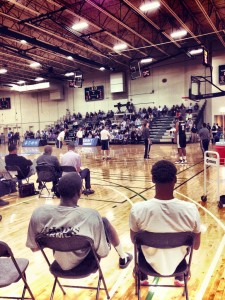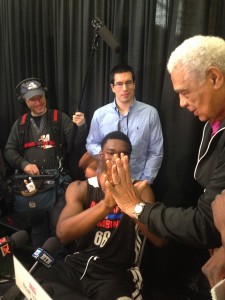CHICAGO – If there was anything to be learned at the 2014 NBA Draft combine, it is that when discussing  prospects, positions are somewhat blown out of proportion.
prospects, positions are somewhat blown out of proportion.
Despite their size, a prospect must must become very well-rounded in order to reach true star status at the next level.
“It’s not new to see guys playing multiple positions,” Tom Penn, an ESPN analyst, told the Wall Street Journal in 2012. “But we’ve never seen this many elite players play multiple positions at an elite level. And what you’re seeing is how little a position matters these days.”
During a period of basketball where “3-pointers and layups” are considered the best shots, being able to step back to the NBA 3-point line and being a good playmaker from the perimeter are increasingly important skills that help to space the floor properly.
“I see plenty of the bigger players with the potential to become stretch 4’s, to play that pick-and-pop game, which is really effective in the league to spread the floor,” said one scout. “I see a few guys who are already pretty good free throw shooters for their size.”
“I think that’s huge today.”
In this article, we’ll focus on 2014 NBA draft prospects Noah Vonleh, Julius Randle, Aaron Gordon and Cleanthony Early (measurements with shoes).
Noah Vonleh, 6-9 1/4, 247.1 pounds, Freshman, Indiana
“I’m versatile,” repeated Vonleh – probably hundreds of times – this past week in interviews with both the media and teams.
As a prospect, he embodies the word.
“I think I proved that I’ve got a pretty good skill set,” he said, regarding his freshman campaign at Indiana. “I can step out and shoot threes.”
While Vonleh’s 11 3/4-inch hand width took the combine by storm, it is his unbelievable rebounding ability (9 per game, which led the Big 10), premier perimeter stroke (16-for-33 3-pointers) and willingness to work hard that will make him extremely tough to pass up on come draft night.
Often the Hoosiers’ lone true “big man,” Vonleh was tasked with sprinting to set screens, banging for position and ultimately carving out space and securing potential rebounds for his team this season.
There was even a game where Vonleh hauled in 14 rebounds and shut Illinois out of second-chance points.
It’s rare for an 18-year-old to display that blue collar mentality, which is a skill, in such a rugged conference on a nightly basis.
And it’s even more impressive when you look at the fact that he worked so hard while playing in an offense that did not consistently leverage his deft perimeter touch (six games with multiple 3-pointers), playmaking ability out of the high post and ability to attack slower players off the bounce. A lot of young big men who don’t receive the ball consistently have a tendency to lose focus on the minor details of the game. It’s natural.
Most of the time, Vonleh did an excellent job of keeping his motor on “high” despite his surroundings, a sign of maturity.
Will it take him time to learn how to play defense without fouling in the NBA? Yes. Are there other areas of his game that he needs work on? Of course.
“My post game has gotten a lot better,” said Vonleh. “It’s still a work in progress. I can still improve on it. I can still improve on a lot of things in my shot, getting my release quicker, being able to push the dribble out and do different things like that, just to make myself an overall better player.”
As Vonleh alluded, one area where he should positively impact the game is in transition. An excellent rebounder and improving ballhandler, as he gains awareness and adjusts to the speed and strategy of the pro game, he should excel at igniting fast breaks with a rebound, a few dribbles and an accurate pass. He’s also a willing and able interior passer who should get better with experience.
He was featured here before during his days at New Hampton Prep, where he once hit a leaning bank shot over Nerlens Noel to win a championship, and he’s rapidly improved since.
At the end of the day, Vonleh’s goal is to develop into the best player he can become.
Where that potential offensive ceiling lies, and what the skill set he possesses will look like when he’s in his prime, will depend on how he hones the moves (pull-up, post) he already has while adding more to the collection.
It’s up to Vonleh to figure out how to use them in order to help take a lottery bound franchise back to relevance.
Julius Randle, 6-9, 249.7, Freshman, Kentucky 
Yes, there was some talk that Randle’s steal rates were low and that he might not measure out well, but a 7-foot wingspan won’t damage his stock.
But Randle did rebound and attack consistently on both ends for a young Kentucky Wildcats team that rallied to play in the national championship.
What he didn’t do this season is shoot particularly well. He shot 70.6 percent from the foul line and just 16.7 percent from the arc.
I saw Randle play in high school, and while he is capable of sprinkling a 3-pointer into his game here and there, he still has work to do to become a more consistent shooter.
“I think they know I can step out,” said Randle, they being NBA executives. “They’ve seen me do it more in high school than in college, so I think they know but they just want to see me get back to it.”
Randle is more of a beast post player than an outside threat at this point, but I do remember him pulling up and knocking down threes on the fast break in high school. He wasn’t a great catch-and-shoot player, but he could make you pay off the bounce.
At Kentucky, he wasn’t asked to be a pull-up shooter. In the NBA, his game won’t be as confined, but despite the trend to shoot 3-pointers at the NBA level, Randle would be wise to keep such attempts to a minimum during his rookie season to maximize efficiency as he gains more comfort and gradually takes more threes. Becoming a consistent mid-range shooter should be the priority for Randle.
“Even when coaches were telling me to shoot, I’d sacrificed it for so long,” Randle trailed off. “Heading into college was the best I’ve shot the ball. I think I’ll be able to get back to it.”
Whether he sacrificed shooting because he was erratic and out of rhythm or because the Kentucky coaching staff didn’t think it was in the best interests of the team, one thing is certain: In order to reach his vast offensive potential, no matter how dominant Randle is in the post, he will have to find his rhythm from the perimeter.
And while he made plays like the one below in college:
In time, he should be capable of more of them at the next level.
How many highlight reel plays a night? That will be determined by how quickly he picks up the pro game, as well as the personnel around him.
